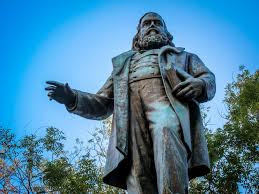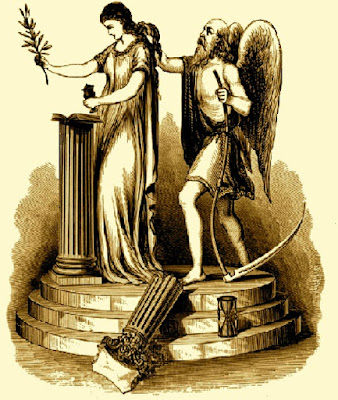 |
| Dave Hosler supplied this cover photo of Battle Ground Lodge 313 in Indiana, where, evidently, physical distancing has been made part of lodge life. The lodge was chartered in 1865. |
Issue 49 (Summer 2020) of The Journal of the Masonic Society has been out for about a month, so let me tell you about it in case you are not yet a member. You’ll find a lot of facts, logic, and reason within its pages.
In fact, the Winding Stairway of the Middle Chamber Lecture in the Fellow Craft Degree (for a great many of us) is presented in several contexts. Jim Rumsey of Texas gives us “The Masonic Philosophy of the Winding Stairway: A Pathway to Enlightenment,” in which he leads us up the stairs, step by step. On Music, for example, this elected member of his grand lodge’s Committee on Work explains how “Music teaches us to manage our time…and to understand that it takes time and patience to accomplish life.” And that “Harmony is bringing all things together and managing conflict.”
Meanwhile, in his “Light from the East Coast,” the President of the Masonic Society brings to our attention the Scottish Enlightenment philosopher Thomas Reid, whose name is noted in the Second Degree section of William Preston’s Illustrations of Masonry. Reid is renowned as the Father of Common Sense. His treatise titled Inquiry into the Human Mind expounds on the Five Physical Senses, also known to Free and Accepted Masons through the MC Lecture, and the President’s point is to urge Freemasons to use their faculties and common sense during the pandemic so as not to be “affected by hysterical media or by politicians who never planned for any emergency.” Hmmm.
Pennsylvania’s William Britton shares “Reflecting on the Reflections of a Newly Made Mason,” an essay that was inspired by a talk he witnessed in a lodge he had visited and that made quite an impact. Sharing his thoughts, for example, on Astronomy, Britton says:
As the seasons change—winter to spring, spring to summer—so the morning changes to midday, then afternoon, and leads us into the center, or middle chamber of the day. With that advancement comes maturity—time when we are fully able to make intellectual decisions in life, rather than using our emotions, relying on rationality as a means to make decisions based on reason. It is here, in the middle chamber, we are given more refined tools that become essential to the precision required in the building process. When a building is being erected, every stone in it must be so placed that the stress of gravity pulls on all portions of the structure in such a manner that its unity and consistency are preserved. Such it is when we base our decisions upon the foundation of rational reason.
I like what he writes in this piece. I think it recalls Stoic philosophy, but you decide for yourself. For as long as I can remember, I’ve been telling anyone who would listen that when our GMHA avows “My l u ma tk; bt m intg nv,” he is not referring to pure, honest duty. He is affirming how his obligations are integral to his being. When one speaks of a building’s structural integrity, he is not talking about the building’s honesty; he is referring to the building’s very ability to exist per the proper applications of the useful rules of architecture. The Emperor Marcus makes this very point in his Stoic reflections we know as the Meditations.
Upon opening this issue of The Journal, I actually landed in the middle, where we find “Masonic Perspectives: A Second Look at Aspects of Controversial Topics in American Freemasonry.” This is one in a series where the authors reach into history to demonstrate how—to borrow Karr’s famous axiom—the more things change, the more they stay the same. In this case, John Bizzack (Masonic Society Board Member) and Dan Kemble examine two articles from the May 1929 issue of The Builder magazine. The first is titled “The Future of Freemasonry,” by Herbert Hungerford, and the second is “Where Are We Drifting?” by R.J. Meekren. You probably can guess what these two vintage articles say, because you probably have been saying the same thing, namely that “we in America have been bitten by the lust for size, for numbers, for wealth.” (Hungerford) And that the “leaders of the Craft have very frequently expressed grave fears in regard to losses from various causes, especially those by suspension for non-payment of dues. Rather less frequently, doubts have been voiced as to whether the growth in the last decade has not been altogether too rapid.” (Meekren)
There is much detail provided in membership statistics, but it is not dry reading. It really is a very important lesson in Masonic practice that future grand masters ought to read and comprehend, so the Craft may break its pointless cycle of initiating and losing such high numbers of brethren.
In The Journal’s Spotlight section, we find an interview with the irrepressible John “Coach” Nagy, a persuasive voice in social media and a prolific author. Here Nagy extols the urgency of research, and illustrates the value of etymology in understanding Masonic vocabulary—something I prize myself. We use the terms Free and Accepted, Freemason, and free stone often enough, and Nagy explains that our word “free” should not be taken merely as “unrestrained,” but as per its French origin, franche, meaning “superior, excellent, pure, master.” The discussion spans three pages, but I wish it went longer.
Likewise looking into word meanings and our need to guard the West Gate, Francis Fritz of Arizona asks “Are We a Secret Society?” It’s a pretty short, but thoughtful, opinion piece that just may cure brethren of reciting a certain ubiquitous catchphrase about a society with secrets. Check it out and decide for yourself.
Giovanni “Joey” Villegas of Manila, Philippines renders a lengthy study in the back of the magazine on the subject of “Masonry in the Time of the Corona Virus,” that naturally was written independently of the President’s message in the front of the magazine, but that synchronously also encourages us to keep calm. After a deep recitation of facts and numbers on how the fraternity worldwide is dealing with the pandemic, Villegas reminds us that “Masonry is indeed about applying the tenets and teachings for the benefit of our brethren and of all mankind. You don’t need to have a meeting to learn and serve Masonry. It was never about collecting degrees or aspiring for positions and awards. It always has been about Brotherly Love (caring), Relief (helping), and Truth (learning).”
The regular features of The Journal consistently help us navigate the Masonic world outside our lodges. In the reviews section, Steven Shimp, a Past Master of St. John’s Lodge 435 in Pennsylvania (I’ve never seen a St. John’s Lodge numbered so high!) praises the Masonic Lite podcast, hosted by five fellow Pennsylvanians. Shimp credits the show for using informal talk to present Masonic education. In the books department, Seth Anthony (another Pennsylvanian!) discusses the Roger Dachez and Alain Bauer book Freemasonry: A French View, which he lauds as “an excellent, short read that is absolutely packed with Masonic knowledge” and that clarifies for the American reader the often vexing story of Freemasonry in France. My friend Dave Tucker of New Jersey sizes up Michael Poll’s Measured Expectations: The Challenges of Today’s Freemasonry, which was honored as the Grand Lodge of Illinois’ book of the year. “Measured Expectations examines the needs of a newly raised Mason,” Tucker writes. “The book is full of very practical observations and suggestions.” Another(!) Keystone State Mason, M. Vincent Cruciani, reviews the insightful Roy Wells’ Some Royal Arch Terms Examined. Noting how the book is more useful to English Royal Arch Masons than to Americans, Cruciani encourages us to read the book for its decoding of Hebrew terms.
Speaking of Mike Poll, the Editor in Chief of The Journal, in his Editor’s Corner column, also addresses Masonic life during the pandemic. (Let me point out that this issue of The Journal went into production in April, so it’s important to appreciate the time lapsed.) He notes the online discussions among Masons, and the organized efforts of brethren to help, aid, and assist the needy, whether they are Masons or not. “We are Masons and have the need to act like Masons.”
Perhaps as a kind of bookend, Masonic Society Second Vice President Greg Knott, in his photography feature “Through the Camera Lens,” takes us on a tour of the Civil War battlefield of Fredericksburg. He shows us the statue of Confederate soldier Richard Kirkland, who was thus memorialized because he risked his neck to bring water to the wounded Union men strewn about the field. “This selfless act is a reminder of the obligation we have as Freemasons to assist our brothers and others who might need some aid,” Knott writes. “During this time of COVID-19 pandemic, let us remember to reach out to our brethren and their families to ensure their well being.”
SMIB.
There still is more to this issue of The Journal of the Masonic Society, but it’s hard for me to believe you’ve read even this far, so see for yourself. It’s the best $45 you’ll spend in Freemasonry.






















































































